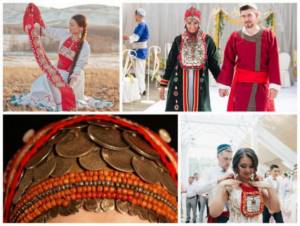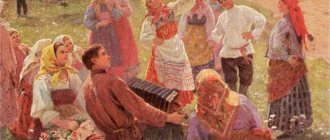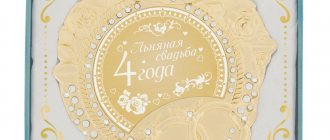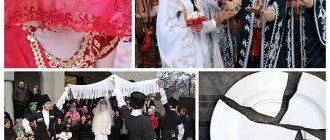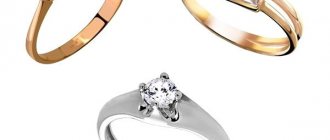A wedding in Bashkiria is considered one of those rituals that has remained virtually unchanged to the present day. However, some traditions have become obsolete in cities, but are still observed in villages.
There was a ritual in the country in which the decision to marry children was made by the parents alone. Moreover, often the couple could not even see each other in the days before the ceremony. The marriage ceremony took place at home with the participation of an invited mullah. But before, the ceremony, if desired, could be held in mosques.
Wedding traditions in Bashkiria
Often relatives thought about the ceremony at a time when the children were not even 5 years old. The engagement ceremony of young people was considered traditional; in Bashkir it sounds like “syrgatuy”. As the time for the wedding ceremony approached, the family began to carefully prepare for it: collecting a dowry, preparing jewelry, and so on. There are several key stages in the Bashkortostan wedding ceremony:
- conducting negotiations and setting the terms and conditions of marriage (collusion and matchmaking);
- Nikah or the wedding ceremony itself;
- traditions and rituals after the wedding.
The traditions of the Bashkir wedding have undergone many changes, but in small settlements they are observed today almost unchanged.
Bridal clothes
The national colorful costume plays an important role during the wedding ceremony. However, the bride’s wedding dress, which is a product quite complex in texture, also receives no less attention. The groom always wears a red sash to the wedding, and the bride wears a multi-colored belt.
One of the rituals of a Bashkir wedding is the transformation of the young woman into a wife. For this purpose, the wedding headdress is replaced with a symbolic female one, which gives the bride the right to cross the threshold of her lover’s house.
Stage of parents' agreement about the wedding
According to Bashkir traditions, the father of the future bride, after talking with his wife, went to the groom and asked his opinion about a possible wedding. The head of the family chose a bride for his son. The mother's participation in the process was limited to observing indirect formalities. After the couple was formed, the girl's father went to her father-in-law and talked about the future ceremony. After receiving consent for the wedding from the bride's father, the topic of bride price came up.
As a sign of confirmation of the conclusion of the marriage agreement, both families had to drink from the same container of kumiss or honey. This was a responsible step, since after it the parents did not have the right to marry off the bride to someone else, even if the decision to marry was hasty and the partner turned out to be unsuitable. This situation could arise, for example, due to the deterioration of the financial condition of the groom’s family. If a decision was made to cancel the wedding, a ransom was provided either in the form of a material part or a share of livestock.

Traditional stages of a wedding
A Tatar wedding begins long before the wedding day.
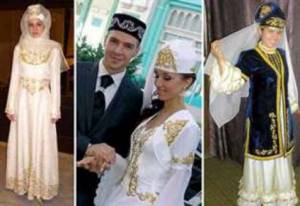
The traditions of a Muslim wedding firmly cement the union of two hearts. After all, both sides of relatives participate in the preparation of the main ceremony. They take upon themselves the solution of the first everyday issues that can cause discord in the new family. So, the customs of preparing for a wedding.
- Matchmaking takes place without the participation of the future newlyweds. Future relatives agree on the ransom amount - kalym. It also turns out whether the future spouses have relatives up to the seventh generation.
- Kalym in the customs of a Tatar wedding is a serious rite. The groom must give gifts not only to the bride, but also to all relatives. The bride, in turn, prepares her dowry. It usually includes clothes for the spouse, towels and rugs.
- The bride's viewing is when the groom's relatives, during negotiations about the wedding, watch and evaluate how the bride pours tea and looks after them.
- The bride must also express her consent to the candidacy of her future spouse. Modern young people, of course, have discussed everything for a long time and agree to have a wedding. However, the bride must nod her head to the mullah's questions about the groom's candidacy. In the old days, the bride had to cry loudly - and thus express her consent.
- An engagement is an announcement that the bride is now a girl of marriageable age who is getting married soon.
- After the engagement, preparations begin for official registration and a long feast.
Official registration precedes the rite of entering into an alliance before Allah. All couples first register with the registry office and then contact the priest. Nikah or nikah is a meeting of young people with the mufti. The ceremony is carried out either in the mosque or at the bride’s home. The young people either read the oaths or repeat the words of the oaths after the clergyman. An interesting fact is that the mufti asks the bride what gift she wants from the groom. It could be gold jewelry, building a house, anything. And during the ceremony, a deadline is set for the fulfillment of the wish.
After registration on earth and in heaven, a feast begins, which lasts at least two days. According to tradition, the first day is celebrated in the bride's house, without the groom's relatives. On the second day, the groom takes the bride to his place. The holiday continues without the bride's relatives.
Kalym: traditions of negotiations
Kalym was determined by the financial condition of both families. Traditionally, it included money, clothing, livestock and other collections of useful items. With the exception of horses, all other gifts were intended for the bride. One of the horses was intended for her father, and the second for dinner at the wedding celebration.
A fox fur coat was often intended for the mother as a ransom. Despite the fact that families themselves set the size of the dowry, there were mandatory points that no one could cancel, and failure to comply with them was considered a sign of disrespect for one of the parties. These points included:
- for the mother a good quality fox fur coat;
- for the father, a horse suitable for farming;
- a second horse for the wedding treat.
They also left a maximum of 15 rubles for additional expenses, which by those standards was an adequate amount.
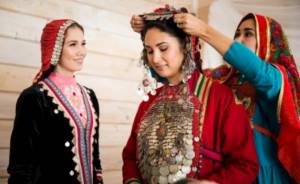
What language is spoken in Bashkiria?
Bashkirs speak Bashkir, which combines features from Kipchak, Tatar, Bulgar, Arabic, Persian and Russian. It is also the official language of Bashkortostan, but it is also spoken in other regions of the Russian Federation.
The Bashkir language is divided into Kuvank, Burzyan, Yurmatian dialects and many others. There are only phonetic differences between them, but despite this, Bashkirs and Tatars easily understand each other.
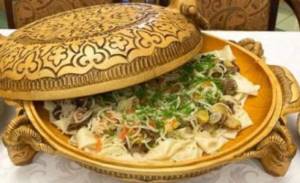
The modern Bashkir language emerged in the mid-1920s. Most of the vocabulary consists of words of ancient Turkic origin. There are no prepositions, prefixes or gender in the Bashkir language. Words are formed using affixes. Stress plays a big role in pronunciation.
Until the 1940s, the Bashkirs used the Volga Central Asian script, and then switched to the Cyrillic alphabet.
Visit to the bride's home
2 days before the groom visits the bride for the first time, her father officially convenes relatives and tells them about the upcoming wedding. During the visit, the mullah formally marries at home. The father on the groom's side must bring a horse with him to the first visit, intended for the table. It is later traditionally stabbed to death. All guests who were invited to the celebration remained in the bride's house. First, the visitors were treated to a traditional dish called bishbarmak, after which the process of giving gifts to the newlywed guests began.
Usually the guests arrived overnight and, since there were many of them, they were distributed by the village elders to the houses of the relatives of the bride’s village. Traditionally, on the next day of the celebration, the brought horse was injected. The role of the men in the process is clear, and the task of the ladies was to check the fat content of the horse meat. Those gathered, aware of the tradition, usually preferred to wear traditional, simple clothes. When the guests arrived at the appointed place, the matchmakers usually attacked them and a traditional wedding brawl began, which sometimes lasted until the morning.
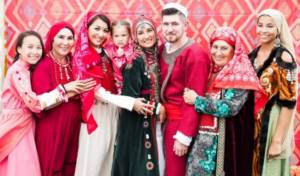
What customs of mutual assistance did the Bashkirs have?
The customs and traditions of the Bashkirs also included mutual assistance. Usually they preceded holidays, but they could also be a separate phenomenon. The most popular are Kaz Umahe (Goose Help) and Kis Ultyryu (Evening Gatherings).
Under Kaz Umakh, a few days before the holidays, the hostess went around the houses of other women she knew and invited them to help her. Everyone happily agreed and, wearing all their most beautiful clothes, gathered at the house of the inviter.
An interesting hierarchy was observed here - the owner slaughtered the geese, the women plucked them, and the young girls washed the birds at the ice hole. Young men were waiting for the girls on the shore, playing the harmonica and singing songs. The girls and boys returned back to the house together, and while the hostess prepared a rich soup with goose noodles, the invitees played “forfeits.” To do this, the girls collected things in advance - ribbons, combs, scarves, rings, and the driver asked a question to one of the girls, who stood with her back to her: “What is the task for the owner of this phantom?” These included singing, dancing, telling a story, playing the kubyz or looking at the stars with one of the young people.
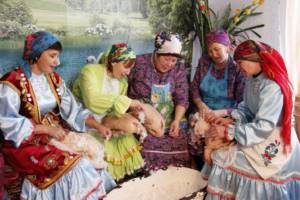
The mistress of the house invited relatives to Kis Ultyryu. The girls were engaged in sewing, knitting and embroidery.
Having finished the work they brought, the girls helped the hostess. Folk legends and fairy tales were always told, music was played, songs were sung and dances were performed. The hostess served tea, sweets and pies to the guests.
Visiting the father-in-law and mother-in-law at the groom's house
After the guests have stayed with the matchmakers for a couple of days, they usually go back to their homes. After which the mother-in-law and father-in-law go to the groom's father. A special women's and men's room was prepared for their arrival. The bride's mother had to bring with her a chest containing gifts and national clothes.
After the dinner ceremony, the men went to the ladies' room. There, the bride's mother invited someone to open the chest, and gave the girl who agreed a scarf. The threads were given to old women, who were supposed to accept them with prayers, but were not obliged to give gifts in return. The shirt was intended for the bride's father in exchange for cattle for the young family. After the ceremony of exchanging gifts, the guests traditionally left for their homes.
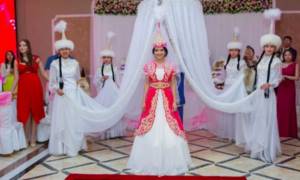
Small Wedding Rite
Traditionally, the wedding ceremony in Bashkiria took place at the house of the bride’s father. Those old people who had previously taken part in the matchmaking ceremony also gathered here. The task of the arriving mullah was to ask the consent of the bride's father for the wedding. If the answer was positive, the mullah read a certain part of the Koran, after which he entered the marriage contract into the so-called metric register. For such an action, the mullah was entitled to compensation of 1% of the total amount of the dowry. After the ceremony, the groom had the right to visit his wife’s house whenever he wanted in the role of a husband.
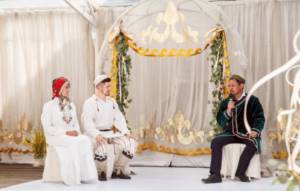
What is the Tui festival?
After the entire dowry was paid, the husband came to his father-in-law for his bride or already legal wife. The father-in-law was obliged to prepare in advance for the visit and organize a holiday called Tui. A wedding in Bashkiria allowed even low-income families to start a family. In this case, instead of the Tui holiday, a small modest treat was arranged. The festival ceremony usually lasted from 1 to 3 days. If the family’s finances allowed, then they could not do without holding various public events such as horse racing and wrestling.
Ceremony of fighting for the bride
This ritual is somewhat similar to competitions for modern young people and consisted in the fact that guests using various methods prevented the bride from leaving her home. The obstacles depended on the imagination of those gathered and the newlyweds themselves: they could either create obstacles or even tie the bride to a pole. Damage caused by the fight was usually paid for by the groom. After the groom’s victory and additional gifts to the bride as compensation for possible moral damage, she was nevertheless taken to the groom’s new home.

Bashkir wedding: traditions
Wedding traditions and rituals of Bashkiria
Parents began to think about the wedding of their children when they were still very young. The traditional ritual according to which the engagement of future spouses takes place in Bashkiria is called “syrgatuy”. Parents agreed on the date of the future wedding, and when it began to approach, they instructed their children to prepare for the wedding ceremony: they collected a dowry, sewed clothes, and equipped the house to receive a large number of guests.
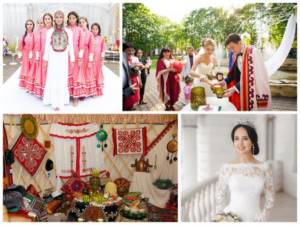
A wedding in Bashkiria consists of several stages:
1. Negotiations between the parties and discussion of the upcoming celebration.
2. Marriage ceremony (nikah).
3. Customs and rituals that are carried out after the wedding.
Parents agree to marry their children
Following the wedding traditions of Bashkiria, the father of the groom, after consulting with his wife, asked his son if he wanted to get married. If the young man agreed, then the father chose a bride for his son. The groom's mother also took part in choosing the bride, but only as an adviser; the father always had the final word. After the candidate for the role of the bride was chosen, the groom's father went to the girl's father to negotiate the upcoming wedding. If the prospective father-in-law agreed to give his daughter in marriage, then they moved on to discussing the dowry.
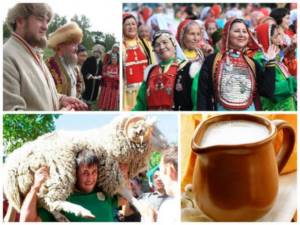
To confirm the marriage agreement, both families, as a sign that they will soon become relatives, must drink honey or kumis from the same cup. After the agreement for the marriage of the young people was accepted, the girl was officially considered to be engaged. From that day on, she became the bride of the guy with whose parents her elders entered into an agreement. They could no longer promise their daughter to someone else, even if over time the chosen groom fell in ranking (for example, his financial condition worsened). If, nevertheless, the father of the Bashkir bride changed his mind about giving his daughter in marriage, then, following tradition, he was obliged to pay a “fine” to the failed father-in-law in money or pets.
Negotiations on bride price
The size of the Bashkir wedding bride price was calculated based on the general financial condition of both families. According to tradition, bride price consisted of livestock, clothes and other valuables. All gifts for the future bride, except horses, were intended for her personally. One of the horses was presented as a gift to the bride's father, and the second was slaughtered and served at the wedding feast. The girl's mother received a fox fur coat. She served as a ransom for her daughter. The size of the Bashkir kalym, in accordance with specific factors, could be different, but obligatory gifts were provided for, which the groom had to give to his future father-in-law and mother-in-law.
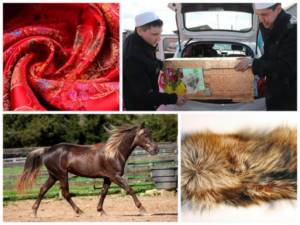
Here is a list of required gifts:
- future mother-in-law - a fox fur coat;
- future father-in-law - a horse;
- for refreshments at the wedding celebration - a second horse (cow or ram);
- 10-15 rubles for expenses;
- fabric for a bridal dress and money for decorations.
The rest of the ransom (if there was any) was given to the girl’s father, who in return gave the young couple money and cattle. On top of everything else, the Bashkir bride received from the groom a “small bride price,” which consisted of a tablecloth, scarf, boots and other things. When an agreement on the size of the dowry was concluded, the deal was sealed with a small feast.
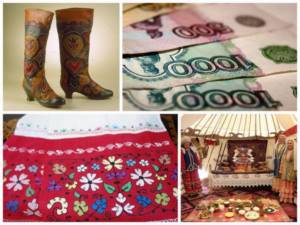
Visit to the bride's home
A few days before the first meeting of the future spouses - on the day of the formal marriage, following the Bashkir wedding tradition, the father called relatives to his house and talked about his daughter’s engagement. The groom's relatives offered help in organizing the wedding celebration, and the bride's parents invited guests from the future spouse to visit their home.
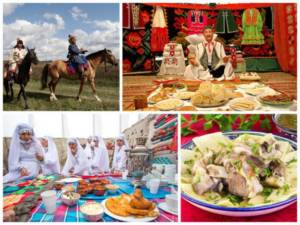
The groom's father, when he went to visit the matchmakers for the first time, brought a horse with him. It was then served as a treat at the wedding feast. All guests who came to the wedding were accommodated in the house of the bride's parents. According to ancient custom, they were served a traditional treat of meat and noodles - bishbarmak. After a small feast, the guests presented gifts to the newlyweds.
On the second day of the Bashkir wedding celebration, a horse was slaughtered. Both men and women took part in this ritual. Representatives of the fairer sex determined the fat content of horse meat. Guests, knowing in advance about the upcoming ritual, dressed in simple casual clothes. When everyone gathered in the appointed place, the matchmakers attacked them screaming, and the traditional fun of the Bashkirs began - a mass brawl.
Arrival of father-in-law and mother-in-law to the groom's father
Soon, the bride's parents came for a return visit to the house of the groom's parents. For their arrival, the matchmakers prepared two rooms: a women's room and a men's room. The mother of the young wife, following the Bashkir wedding tradition, brought with her a chest containing: a scarf, scraps of cotton fabric, threads and a shirt. After dinner, the men went to the women's room, in which the bride's mother invited the women present there to open the lid of the chest.
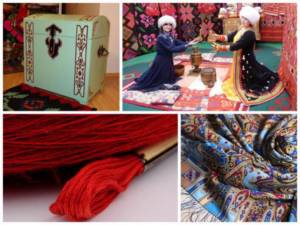
A woman who agreed to open a chest received a scarf as a gift, and she sold scraps of chintz to men for little money. The threads were given to the oldest women who prayed for the newlyweds. The shirt, according to tradition, was given to the father of the young spouse. In return, he gave new relatives pets. After all the gifts were distributed, the matchmakers took their leave and went home.
Small wedding
The wedding ceremony in Bashkiria took place in the girl’s parental home, where the old people who were present during the matchmaking gathered. A mullah was invited to this small wedding and asked the bride’s father: does he agree to give his daughter in marriage? If the father gave his consent, the mullah read lines from the Koran and recorded the registration of the marriage in the birth register. According to tradition, the mullah was paid 1% of the total amount of kalym for this work. Now the groom received permission to come to his bride’s house as a husband.
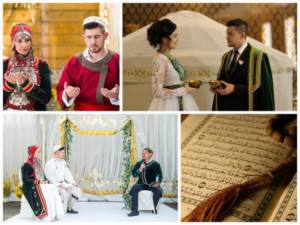
Tui Festival
After all the formalities with the wedding price were completed, the groom and his relatives came to the house of his beloved mother-in-law and father-in-law. Here they prepared in advance for the meeting of new relatives and organized the traditional Tui celebration, which traditionally lasted 2-3 days. Wealthy parents organized a luxurious holiday with horse races, games, delicious and hearty national dishes. However, if the girl’s father did not have a lot of money, he treated the guests according to his capabilities. Nobody blamed him for the modest holiday.
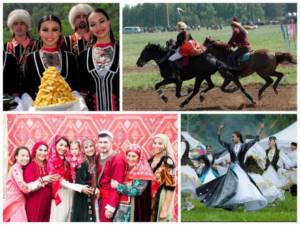
Departure of the bride to her husband's house
It was not so easy for a young Bashkir wife to go to her husband’s house. The newlywed's sister and all her female relatives arranged intrigues and obstacles for the spouses. The young woman's bed was tied in a knot and carried into the forest, and the ends of the rope were hidden under the roots of trees. The bride herself was seated on a “naked” bed, and a fight for her began between the groom’s friends and relatives. This ancient wedding tradition of Bashkiria was always very fun, but caused damage to the budget of relatives due to the large number of torn clothes.
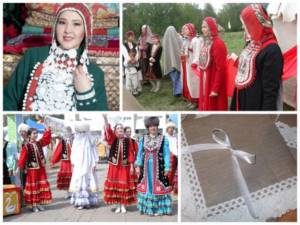
Before the young wife left, the girl’s relatives were waiting for her to visit them for a traditional farewell. The newlywed went to all the houses of relatives in the village. Together with her, the procession consisted of four friends, who held a scarf over the girl’s head and cried. The young wife presented each relative with a tablecloth, threads and a towel. In exchange, she was given money and other valuables. At the end of this ritual, the girl was dressed in her best outfit and escorted to a cart, on which she went to her husband. But here, too, not everything was smooth sailing. According to tradition, the girl had to resist and agreed to go only when she received gifts from her father and brothers.
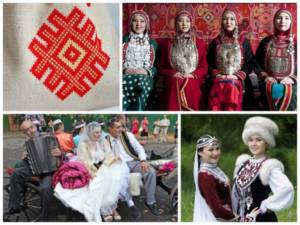
Following the wedding tradition of Bashkiria, one of the relatives was traveling with the new wife. She had to carry out the ceremony of selling a young wife to her father-in-law. When the daughter-in-law entered her husband’s house for the first time, she knelt down in front of her husband’s parents three times. Following the ritual, each father-in-law lifted her from her knees, thereby showing goodwill towards the new relative. After the ceremony was completed, the newlywed gave gifts to her husband’s relatives, and they responded in kind.
After the wedding
The morning after the Bashkir wedding, the young wife was given a rocker and buckets and sent to the well for water. She took with her a coin tied to a string. The young wife presented this gift to the water spirit, who, according to legend, lives in the well. During this ritual, the young Bashkir wife was surrounded by children, they were trying to pull a coin out of the well. After this ritual, the wife could no longer be ashamed of her husband and open her face to him.
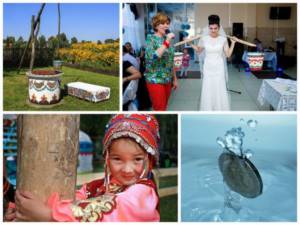
What is customary for young people in Bashkiria to wear to a wedding?
They prepared for the wedding in Bashkiria carefully and in advance. Festive clothes were sewn for the newlyweds, which they could wear during other holidays. The wedding celebration was full of bright colors: women were dressed in bright dresses with multi-colored skirts and satin ribbons, patterns, and frills. In some regions of Bashkiria, traditional wedding clothes of the bride were decorated with embroidery. A robe or camisole was put on top of the dress.
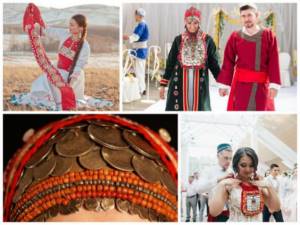
One of the main wedding rituals of Bashkiria was the ritual of dressing the newlywed in a woman’s outfit. After that, she was taken to her husband's house. The same applied to the bride’s headdress. Often during the wedding celebration, she was removed from her girl’s headdress and put on a woman’s one. In the South and East of Bashkiria, the headdress of the newlywed was a headscarf, on top of which they wore a kashmau with corals in the shape of a helmet. Kashmau is the headdress of Bashkir married women. In other regions of Bashkiria, the bride wore a cap embroidered with beads on her head.
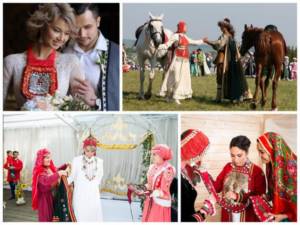
In Bashkiria, it is customary to give clothes with handmade designs. For example, before the wedding celebration, a young woman presented her future husband with a shirt with embroidered sleeves and collar. She also gave the newlywed a skullcap and pants. The color scheme of the wedding dresses was very symbolic. Shades of red, green and blue were considered traditional. The groom girded himself with a red sash, and the bride wore a belt made of scraps of bright fabric.
Video: traditional Bashkir wedding
Traditionally, a wedding in Bashkiria was considered a very important event - a new national family was created, children were born. Therefore, marriage was important not only for the personal happiness of the young, but also for their people and offspring. Previously, a Bashkir wedding lasted several days and sometimes weeks, but now such a celebration is celebrated more modestly and all wedding traditions are not always followed. Watch our video and draw your own conclusions.
Bride moving to a new family
Before the final departure, the young people had to say goodbye to their relatives by visiting all the houses in the village. According to tradition, the girl was surrounded by 4 friends, who were supposed to cry and raise a symbolic scarf over the bride’s head. Female relatives were presented with unique gifts such as tablecloths or scarves. In response, the ladies gave the intended girl money and other material assets. After visiting all the houses, the bride was usually put in a cart and before that dressed in her best costumes. According to tradition, the girl had to resist until her father or brother gave her a gift or a kind of ransom.
Another tradition provided for the bride to be accompanied by a relative, who was supposed to receive a ransom for her from the groom's father. After arriving at the new house, the bride knelt 3 times in front of the groom's family, and after each time they raised her. After the ritual, the traditional exchange of gifts took place.
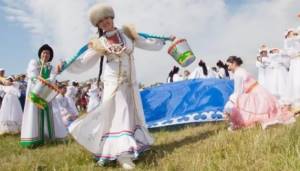
Post-wedding rituals
The next day, the family could send the bride with rockers to fetch water. She usually took with her a silver coin, which was tied on a thread. This symbol was considered a sacrifice of a young wife to a water spirit. But the children sometimes tried to catch the coin. In any case, after the girl threw her into the water, it was believed that she could walk to any body of water without hindrance.
How did you settle in your spouse’s house?
After the Tui holiday, there were their own traditions and customs, which were mentioned earlier, but they are worth summarizing. So, the tradition included:
- the bride kneeling three times in front of the new family, followed by her relatives lifting her up;
- mutual exchange of gifts with the bride;
- visiting a river or pond with a special talisman for safety from water spirits.
The tradition also included the initial revelation of the bride’s face to her husband after the previous rituals were performed.
The process of changing status from bride to wife also occurred with certain traditions:
- a girl's hairstyle was changed from one braid to two;
- replacing a girl's headdress with a woman's one. By the way, the girl’s one is called Takiyya, and the women’s one is popularly called Kashmau;
- tying a belt as a symbol of happiness, good luck and family well-being.
But not only the bride had certain rituals for changing social status. A man also had a number of customs, the observance of which was mandatory in order to be recognized as a full-fledged husband. Here they are:
- obtaining consent to marriage;
- secret adventures with the bride;
- entry into adult family life.
The rituals were also accompanied by additional training for the young couple in the wisdom of adult life from the older generation.
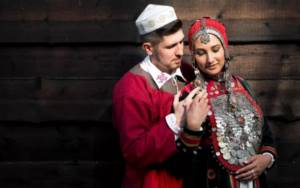
Pre-wedding chores
So, the wedding rituals of the Tatars can be divided into three main actions: pre-wedding, the wedding itself and post-wedding.
Pre-wedding events include matchmaking, which is consent to marriage and stipulation of the conditions for its conclusion. The groom's relatives were most often sent as matchmakers. However, as K. Nasyri noted, “it also happens that the bride’s parents themselves send matchmakers to the groom’s house, who hint that if they asked for their daughter, they would not be refused.”
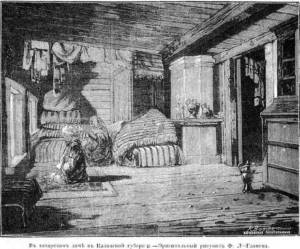
In a Tatar house. Photo zidanio.livejournal.com
The matchmakers not only had to speak well when talking about the applicant, but they also had to have peculiarities in their clothing. So for the matchmaker, one pant leg rolled up above the knee, and for the matchmaker it extended over the top of the boot.
After the first visit to the matchmakers, and they could come five or six times before receiving an answer, the parents gathered close relatives for advice. During each of the matchmakers’ visits, they negotiated about what would be given as a gift from the groom (kalyn
) and in what quantity. Outer and underwear, hats, and shoes were used as gifts. Moreover, feather beds were an obligatory part. Often, the kalyn included livestock - a horse, cow, sheep, poultry, etc. In addition, before the wedding, the groom had to pay the agreed amount of money (which was usually used by the bride’s parents to prepare a dowry, gifts), and also bring a certain quantity of products - meat, butter, milk, honey, tea. According to K.F. Fuchs, kalyn could amount “to rich Tatars in Kazan from three to five thousand rubles, depending on the condition of the bride and groom. In villages, the wealthy have from two hundred to five hundred rubles, the poor from fifty to one hundred rubles.”
Upon reaching mutual agreement between the parties, the bride's parents invited both the groom's parents and the matchmakers to the engagement agreement, where the parties exchanged gifts as a sign of the final agreement. Upon returning to the house, the groom's parents arranged a festive meal, during which everyone was informed about the bride's consent, the timing of the wedding, the guests and their possible assistance in preparing the ransom. The gifts received were displayed to the guests, and all those present allocated a small amount of money for the bride.
After the engagement agreement, meetings were held between future relatives with a mutual exchange of gifts and refreshments to introduce them to each other. During this pre-wedding time, there was a ritual of viewing the bride. It could have slightly different variations, but the basis was the same, when the groom’s mother and his relative met their daughter-in-law. So, for example, in some areas (based on materials from R.K. Urazmanova), the groom’s mother had to recognize “her” among other young girls covered with a scarf/shawl. Afterwards mutual gifting took place. A bachelorette party with wedding refreshments was also held at the bride's house.

After the treat, the groom left a gift for the bride, sitting in another room or behind a curtain. Photo aif.ru
Not only relatives, but also friends gathered for the bachelor party, held at the groom's house. The groom gave the guests small gifts and received money in return. On the night before the wedding, a “night wedding” could be held, when the groom and friends were invited to an evening tea party at the bride’s house. After the treat, the groom left a gift for the bride, sitting in another room or behind a curtain.
Thus, the pre-wedding ritual part included repeated visits to the newlyweds' relatives to meet each other, exchange gifts and assist in preparing the wedding.
About the wedding ceremony itself (nikah) and post-wedding traditions - continued
Dina Gatina-Shafikova
Reference
Dina Gatina-Shafikova is a research fellow at the Department of Ethnological Research at the Institute of History. Sh. Marjani AN RT.
- In 2010 she graduated from the Faculty of History, Department of Archeology at the Kazan (Volga Region) Federal University.
- In 2014, she completed her postgraduate studies at the Institute of History. Sh. Marjani AN RT.
- From 2010 to 2013, employee of the National Museum of the Republic of Tatarstan.
- Research interests: visual anthropology, Tatar costume, history of the Volga-Ural Tatars.
- Author of a number of popular science and research publications. Columnist of Realnoe Vremya.
Traditional marriage prohibitions
The main ban in Bashkiria was that a man could marry a woman of his own kind. Kinship was considered between relatives of 4 generations. Relatives in the fifth and sixth generations could marry, in other words, tyua ayat and ete ayat. The girl's marriageable age was 14-15 years old; ideally, the husband should be at least 3 years older than her.
Until the 20th century, levirate was considered the rule of law in Bashkiria. This is a form of marriage in which a widow could marry the brother of the deceased if she wished. Any other relative of the deceased could also give money to the widow. Not only the children and property of the deceased, but also his entire social position and fortune passed to the widow’s new husband. This system contributed to less labor drain, for example, within wealthy dynasties and families.
